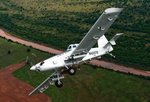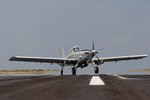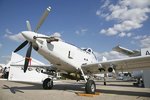Yahoo! Image Detail for http://1000aircraftphotos.com/Contributions/KleinBernhard/4825.jpg
Remarks by Bernhard C. F. Klein: "Designed by Rutan Aircraft Factory, this is the Scaled Composites Model 151 "ARES" (Agile Responsive Effective Support) designed as a "Mud fighter" ground support aircraft in response to the US Army's request for a Low Cost Battlefield Attack Aircraft (LCBAA). It is powered by a single Pratt Whitney JT15D-1 turbojet engine. The original design was a pusher turboprop and evolved into the current design when Scaled Composites decided to build N151SC as a demonstrator. The ARES first flew on February 19, 1990 and is still available for use as a research testbed."
Remarks by Bernhard C. F. Klein: "Designed by Rutan Aircraft Factory, this is the Scaled Composites Model 151 "ARES" (Agile Responsive Effective Support) designed as a "Mud fighter" ground support aircraft in response to the US Army's request for a Low Cost Battlefield Attack Aircraft (LCBAA). It is powered by a single Pratt Whitney JT15D-1 turbojet engine. The original design was a pusher turboprop and evolved into the current design when Scaled Composites decided to build N151SC as a demonstrator. The ARES first flew on February 19, 1990 and is still available for use as a research testbed."





